Real-Time Identification of Cyanobacteria Blooms in Lakeshore Zone Using Camera and Semantic Segmentation: A Case Study of Lake Chaohu (Eastern China)
Abstract
1. Introduction
2. Study Area and Data
2.1. Study Area
2.2. Data
3. Method
3.1. Cyanobacteria Blooms Identification Process
3.2. Multi-Thread Mechanism Construction
3.3. Sample Set Production
3.4. Model Improvement and Training
3.5. Calculation of Cyanobacteria Blooms Coverage
4. Result
4.1. Identification of Cyanobacteria Blooms
4.2. Calculation of Cyanobacteria Blooms Coverage
4.3. Chaohu Case Study
5. Discussion
6. Conclusions
Author Contributions
Funding
Institutional Review Board Statement
Informed Consent Statement
Data Availability Statement
Conflicts of Interest
References
- Brooks, B.W.; Lazorchak, J.M.; Howard, M.D. Are harmful algal blooms becoming the greatest inland water quality threat to public health and aquatic ecosystems? Environ. Toxicol. Chem. 2016, 35, 6–13. [Google Scholar] [CrossRef] [PubMed]
- Amorim, C.A.; do Nascimento Moura, A. Ecological impacts of freshwater algal blooms on water quality, plankton biodiversity, structure, and ecosystem functioning. Sci. Total Environ. 2021, 758, 143605. [Google Scholar] [CrossRef]
- Wu, T.; Zhu, G.; Zhu, M. Effects of algae proliferation and density current on the vertical distribution of odor compounds in drinking water reservoirs in summer. Environ. Pollut. 2021, 288, 117683. [Google Scholar] [CrossRef]
- Hou, X.; Feng, L.; Dai, Y. Global mapping reveals increase in lacustrine algal blooms over the past decade. Nat. Geosci. 2022, 15, 130–134. [Google Scholar] [CrossRef]
- Huang, J.; Zhang, Y.; Huang, Q. When and where to reduce nutrient for controlling harmful algal blooms in large eutrophic lake Chaohu, China? Ecol. Indic. 2018, 89, 808–817. [Google Scholar] [CrossRef]
- Ma, J.; Jin, S.; Li, J. Spatio-temporal variations and driving forces of harmful algal blooms in Chaohu Lake: A multi-source remote sensing approach. Remote Sens. 2021, 13, 427. [Google Scholar] [CrossRef]
- Tang, X.; Shen, M.; Duan, H. Temporal and spatial distribution of algal blooms in Lake Chaohu, 2000–2015. J. Lake Sci. 2017, 29, 276–284. [Google Scholar]
- Yuan, J.; Cao, Z.; Shen, M.; Qi, T.; Duan, H. Remote sensed analysis of spatial and temporal variation in algal blooms phenology in Lake Chaohu since 1980s. J. Lake Sci. 2022, 1, 18. [Google Scholar]
- Yoon, H.; Kim, H.C.; Kim, S. Long-term seasonal and temporal changes of hydrogen peroxide from cyanobacteria blooms in fresh waters. J. Environ. Manag. 2021, 298, 113515. [Google Scholar] [CrossRef]
- Mishra, S.; Stumpf, R.P.; Schaeffer, B.A. Measurement of cyanobacteria blooms magnitude using satellite remote sensing. Sci. Rep. 2019, 9, 1–17. [Google Scholar] [CrossRef] [PubMed]
- Shi, K.; Zhang, Y.; Qin, B. Remote sensing of cyanobacteria blooms in inland waters: Present knowledge and future challenges. Sci. Bull. 2019, 64, 1540–1556. [Google Scholar] [CrossRef]
- Sayers, M.J.; Grimm, A.G.; Shuchman, R.A. Satellite monitoring of harmful algal blooms in the Western Basin of Lake Erie: A 20-year time-series. J. Great Lakes Res. 2019, 45, 508–521. [Google Scholar] [CrossRef]
- Caballero, I.; Fernández, R.; Escalante, O.M. New capabilities of Sentinel-2A/B satellites combined with in situ data for monitoring small harmful algal blooms in complex coastal waters. Sci. Rep. 2020, 10, 1–14. [Google Scholar] [CrossRef] [PubMed]
- Huang, C.; Shi, K.; Yang, H. Satellite observation of hourly dynamic characteristics of algae with Geostationary Ocean Color Imager (GOCI) data in Lake Taihu. Remote Sens. Environ. 2015, 159, 278–287. [Google Scholar] [CrossRef]
- Zhang, Y.; Zhang, Y.; Li, N.; Sun, X.; Wang, W.; Qin, B.; Zhu, G. Capturing the rapid intra-day change of cyanobacteria blooms by land-based hyperspectral remote sensing in Lake Taihu. J. Lake Sci. 2021, 33, 1951–1960. [Google Scholar]
- Ma, T.; Xiao, P.; Zhang, X.; Duan, H.; Qiu, Y. Real-time monitoring of cyanobacteria blooms dynamics around Lake Chaohu based on video surveillance images. J. Lake Sci. 2022, 34, 1840–1853. [Google Scholar]
- Jiang, F.; Grigorev, A.; Rho, S. Medical image semantic segmentation based on deep learning. Neural Comput. Appl. 2018, 29, 1257–1265. [Google Scholar] [CrossRef]
- Abdar, M.; Pourpanah, F.; Hussain, S. A review of uncertainty quantification in deep learning: Techniques, applications and challenges. Inf. Fusion 2021, 76, 243–297. [Google Scholar]
- Long, J.; Shelhamer, E.; Darrell, T. Fully convolutional networks for semantic segmentation. In Proceedings of the IEEE Conference on Computer Vision and Pattern Recognition, Boston, MA, USA, 7–12 June 2015; pp. 3431–3440. [Google Scholar]
- Ronneberger, O.; Fischer, P.; Brox, T. U-net: Convolutional networks for biomedical image segmentation. In Proceedings of the International Conference on Medical Image Computing and Computer-Assisted Intervention, Munich, Germany, 5–9 October 2015; Springer: Cham, Switzerland, 2015; pp. 234–241. [Google Scholar]
- Son, S.; Lee, S.-H.; Bae, J.; Ryu, M.; Lee, D.; Park, S.-R.; Seo, D.; Kim, J. Land-Cover-Change Detection with Aerial Orthoimagery Using SegNet-Based Semantic Segmentation in Namyangju City, South Korea. Sustainability 2022, 14, 12321. [Google Scholar] [CrossRef]
- Zhao, H.; Shi, J.; Qi, X. Pyramid scene parsing network. In Proceedings of the IEEE Conference on Computer Vision and Pattern Recognition, Honolulu, HI, USA, 21–26 July 2017; pp. 2881–2890. [Google Scholar]
- Chen, L.C.; Zhu, Y.; Papandreou, G. Encoder-decoder with atrous separable convolution for semantic image segmentation. In Proceedings of the European Conference on Computer Vision, Munich, Germany, 8–14 September 2018; pp. 801–818. [Google Scholar]
- Matin, M.M.H.; Khatun, A.; Moazzam, M.G.; Uddin, M.S. An efficient disease detection technique of rice leaf using AlexNet. J. Comput. Commun. 2020, 8, 49. [Google Scholar] [CrossRef]
- Qian, M.; Li, Y.; Zhao, Y.; Yu, X. Prior Knowledge-Based Deep Convolutional Neural Networks for Fine Classification of Land Covers in Surface Mining Landscapes. Sustainability 2022, 14, 12563. [Google Scholar] [CrossRef]
- He, K.; Zhang, X.; Ren, S. Deep residual learning for image recognition. In Proceedings of the IEEE Conference on Computer Vision and Pattern Recognition, Las Vegas, NV, USA, 27–30 June 2016; pp. 770–778. [Google Scholar]
- Al-Jubouri, H.A.; Mahmmod, S.M. A comparative analysis of automatic deep neural networks for image retrieval. TELKOMNIKA Telecommun. Comput. Electron. Control 2021, 19, 858–871. [Google Scholar] [CrossRef]
- Theckedath, D.; Sedamkar, R.R. Detecting affect states using VGG16, ResNet50 and SE-ResNet50 networks. SN Comput. Sci. 2020, 1, 1–7. [Google Scholar] [CrossRef]
- Takisawa, N.; Yazaki, S.; Ishihata, H. Distributed deep learning of ResNet50 and VGG16 with pipeline parallelism. In Proceedings of the 2020 Eighth International Symposium on Computing and Networking Workshops (CANDARW), Naha, Japan, 24–27 November 2020; IEEE: Piscataway, NJ, USA, 2020; pp. 130–136. [Google Scholar]
- Wang, X.; Zhang, M.; Yin, J. Composition and influential factors of phytoplankton function groups in Lake Chaohu. J. Lake Sci. 2018, 30, 431–440. [Google Scholar]
- Zhang, M.; Kong, F. The process, spatial and temporal distributions and mitigation strategies of the eutrophication of Lake Chaohu (1984–2013). J. Lake Sci. 2015, 27, 791–798. [Google Scholar]
- Guo, H.; Liu, H.; Lyu, H. Is there any difference on cyanobacteria blooms patterns between Lake Chaohu and Lake Taihu over the last 20 years? Environ. Sci. Pollut. Res. 2022, 29, 40941–40953. [Google Scholar] [CrossRef] [PubMed]
- Han, S.H.; Lee, K.Y. Implemetation of image classification CNN using multi thread GPU. In Proceedings of the International SoC Design Conference, Seoul, Republic of Korea, 5–8 November 2017; IEEE: Piscataway, NJ, USA, 2017; pp. 296–297. [Google Scholar]
- Lyu, K.; Li, Y.; Zhang, Z. Attention-aware multi-task convolutional neural networks. IEEE Trans. Image Process. 2019, 29, 1867–1878. [Google Scholar] [CrossRef]
- Kim, C.G. An implementation and performance evaluation of fast web crawler with Python. J. Semicond. Disp. Technol. 2019, 18, 140–143. [Google Scholar]
- Mascarenhas, S.; Agarwal, M. A comparison between VGG16, VGG19 and ResNet50 architecture frameworks for Image Classification. In Proceedings of the 2021 International Conference on Disruptive Technologies for Multi-Disciplinary Research and Applications, Bengaluru, India, 19–21 November 2021; IEEE: Piscataway, NJ, USA, 2021; Volume 1, pp. 96–99. [Google Scholar]
- Jafari, N.H.; Li, X.; Chen, Q.; Le, C.Y.; Betzer, L.P.; Liang, Y. Real-time water level monitoring using live cameras and computer vision techniques. Comput. Geosci. 2021, 147, 104642. [Google Scholar] [CrossRef]
- An, S.; Rui, X.A. High-Precision Water Body Extraction Method Based on Improved Lightweight U-Net. Remote Sens. 2022, 14, 4127. [Google Scholar] [CrossRef]
- Fu, J.; Yi, X.; Wang, G.; Mo, L.; Wu, P.; Kapula, K.E. Research on Ground Object Classification Method of High Resolution Remote-Sensing Images Based on Improved DeeplabV3+. Sensors 2022, 22, 7477. [Google Scholar] [CrossRef] [PubMed]
- Wang, Z.; Wang, J.; Yang, K.; Wang, L.; Su, F.; Chen, X. Semantic segmentation of high-resolution remote sensing images based on a class feature attention mechanism fused with Deeplabv3+. Comput. Geosci. 2022, 158, 104969. [Google Scholar] [CrossRef]
- Verma, U.; Chauhan, A.; Manohara Pai, M.M.; Pai, R. DeepRivWidth: Deep learning based semantic segmentation approach for river identification and width measurement in SAR images of Coastal Karnataka. Comput. Geosci. 2021, 154, 104805. [Google Scholar] [CrossRef]
- Wynne, T.T.; Mishra, S.; Meredith, A.; Litaker, R.W.; Stumpf, R.P. Intercalibration of MERIS, MODIS, and OLCI Satellite Imagers for Construction of Past, Present, and Future Cyanobacterial Biomass Time Series. Remote Sens. 2021, 13, 2305. [Google Scholar] [CrossRef]
- Castagna, A.; Simis, S.; Dierssen, H.; Vanhellemont, Q.; Sabbe, K.; Vyverman, W. Extending Landsat 8: Retrieval of an Orange contra-Band for Inland Water Quality Applications. Remote Sens. 2020, 12, 637. [Google Scholar] [CrossRef]
- Yan, K.; Li, J.; Zhao, H.; Wang, C.; Hong, D.; Du, Y.; Mu, Y.; Tian, B.; Xie, Y.; Yin, Z.; et al. Deep Learning-Based Automatic Extraction of Cyanobacterial Blooms from Sentinel-2 MSI Satellite Data. Remote Sens. 2022, 14, 4763. [Google Scholar] [CrossRef]
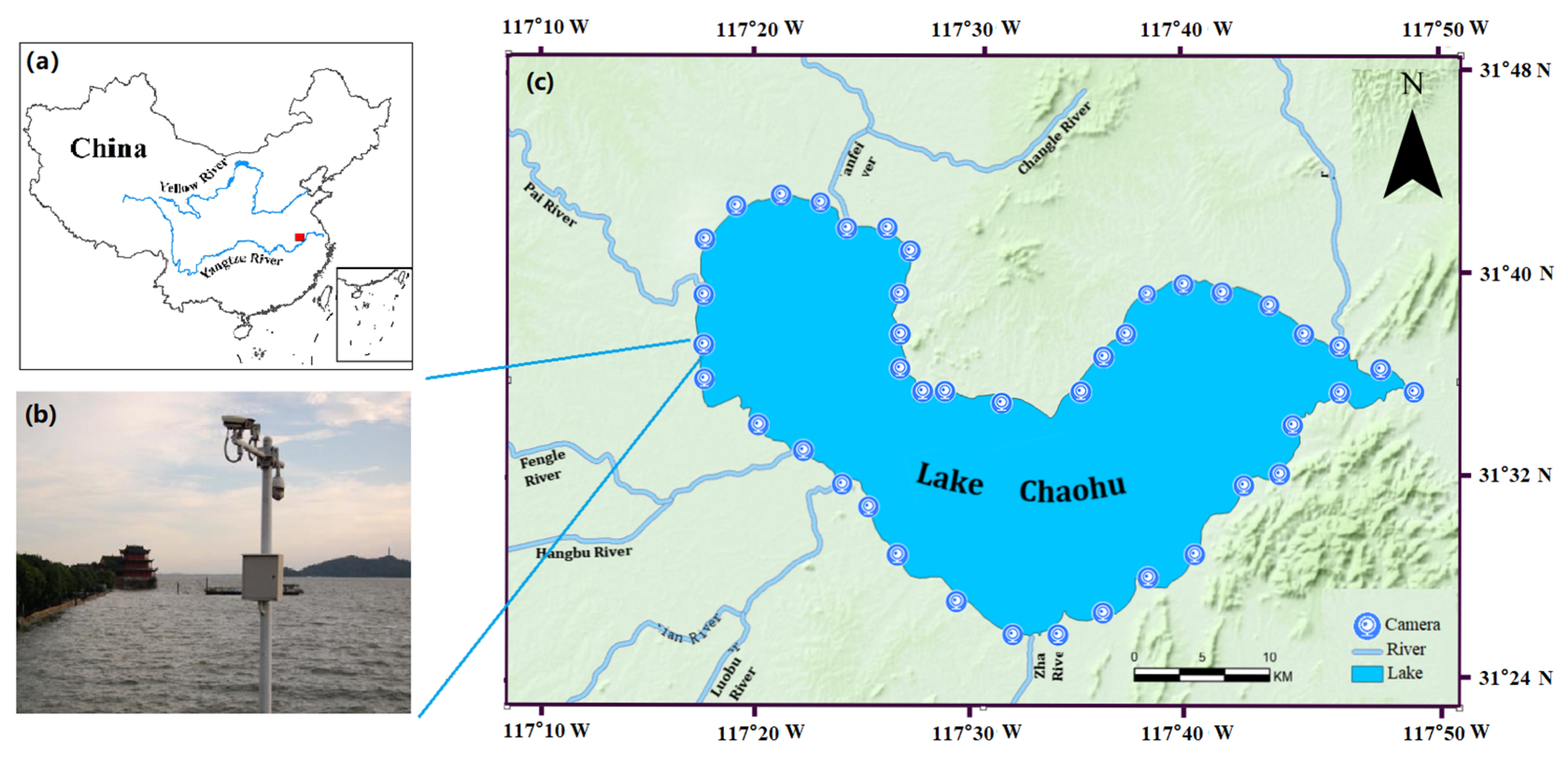
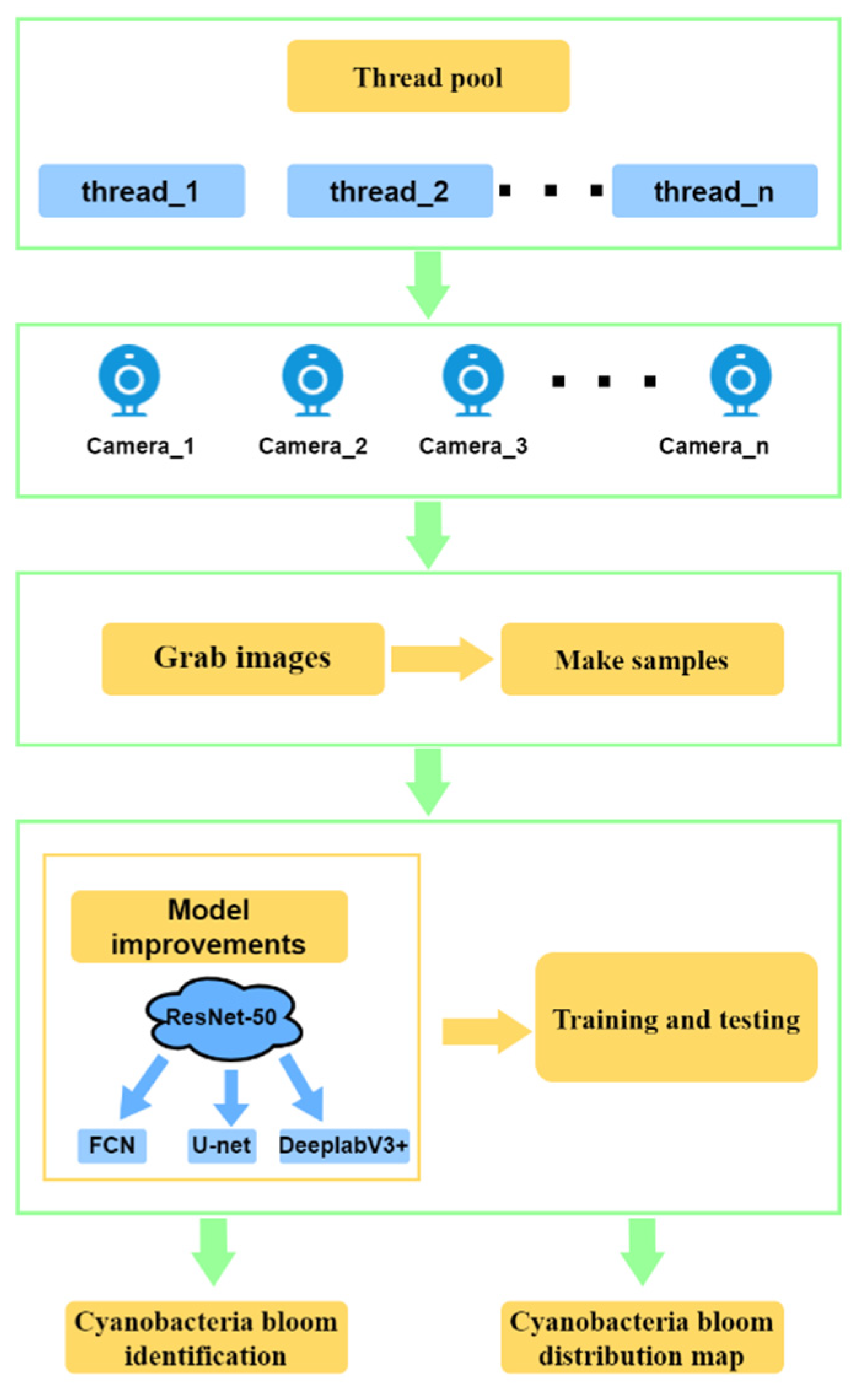

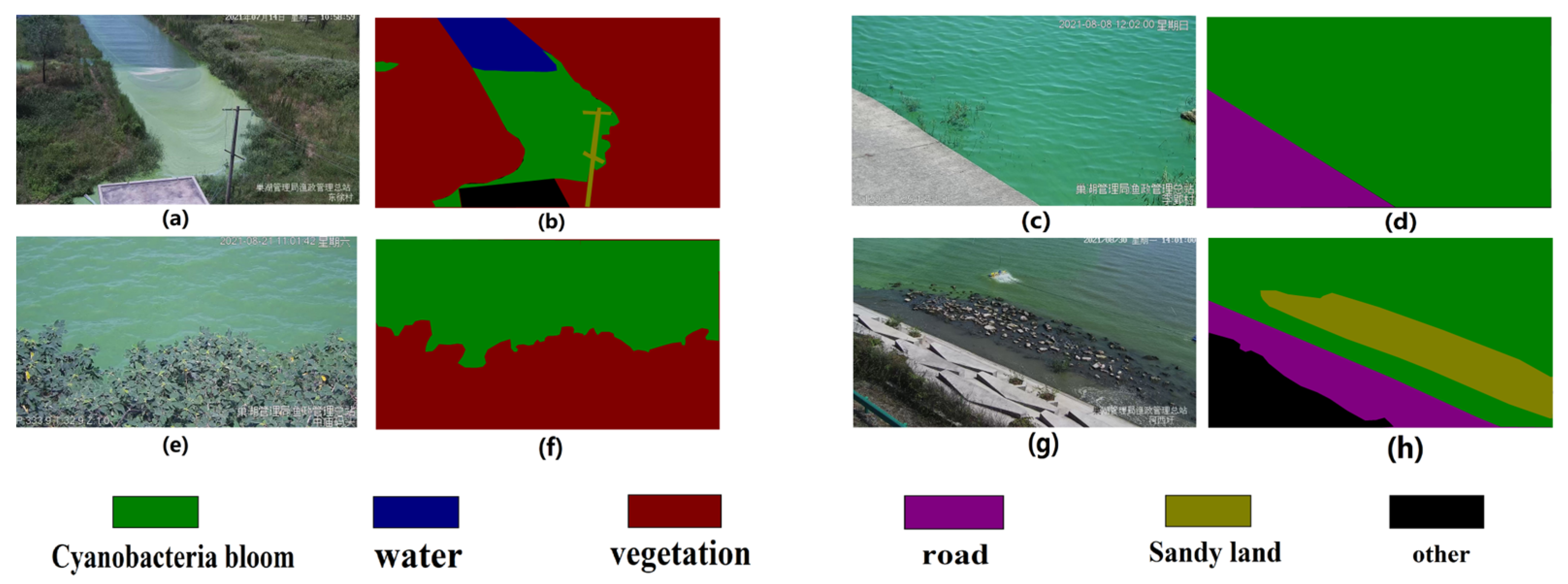
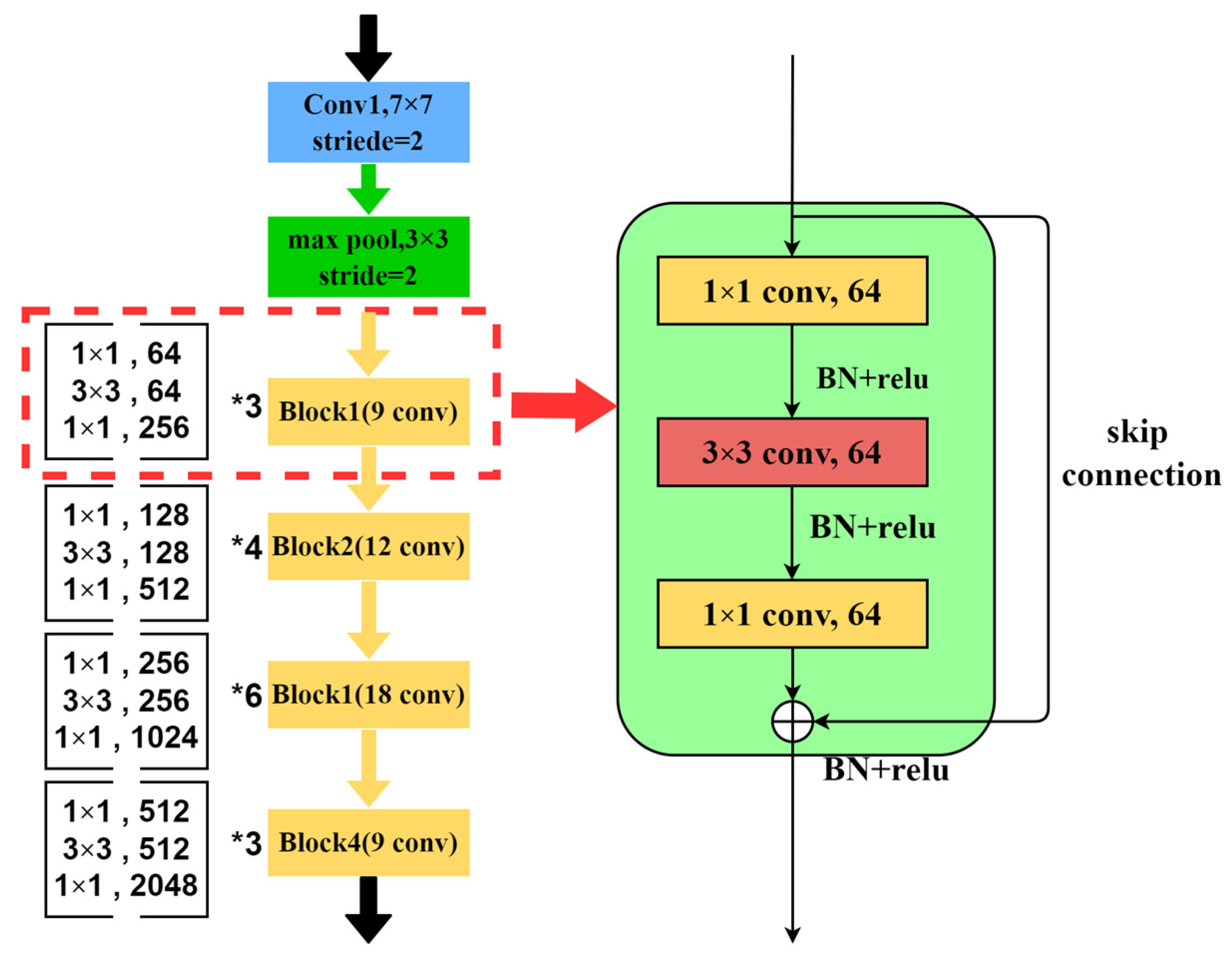

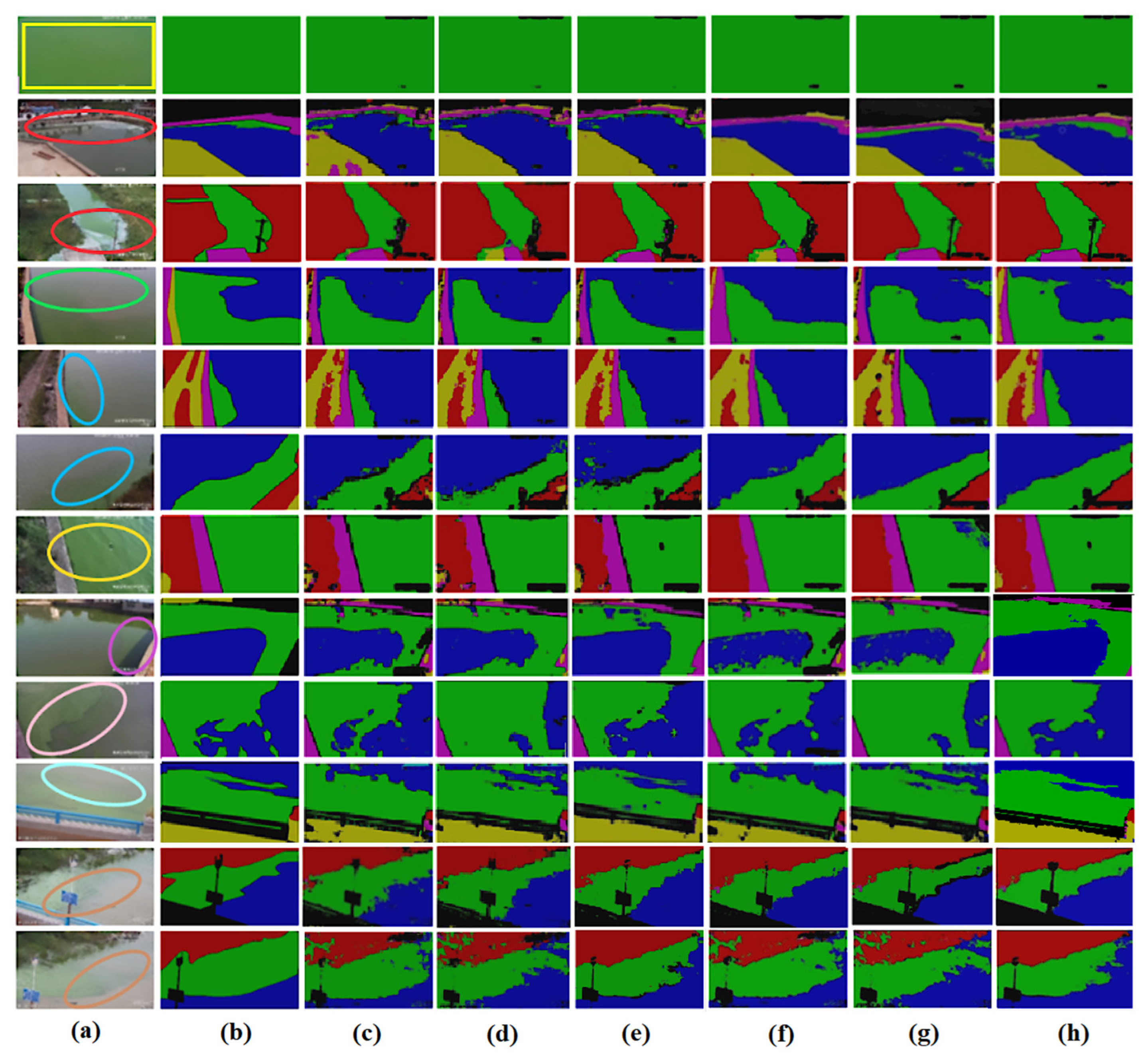
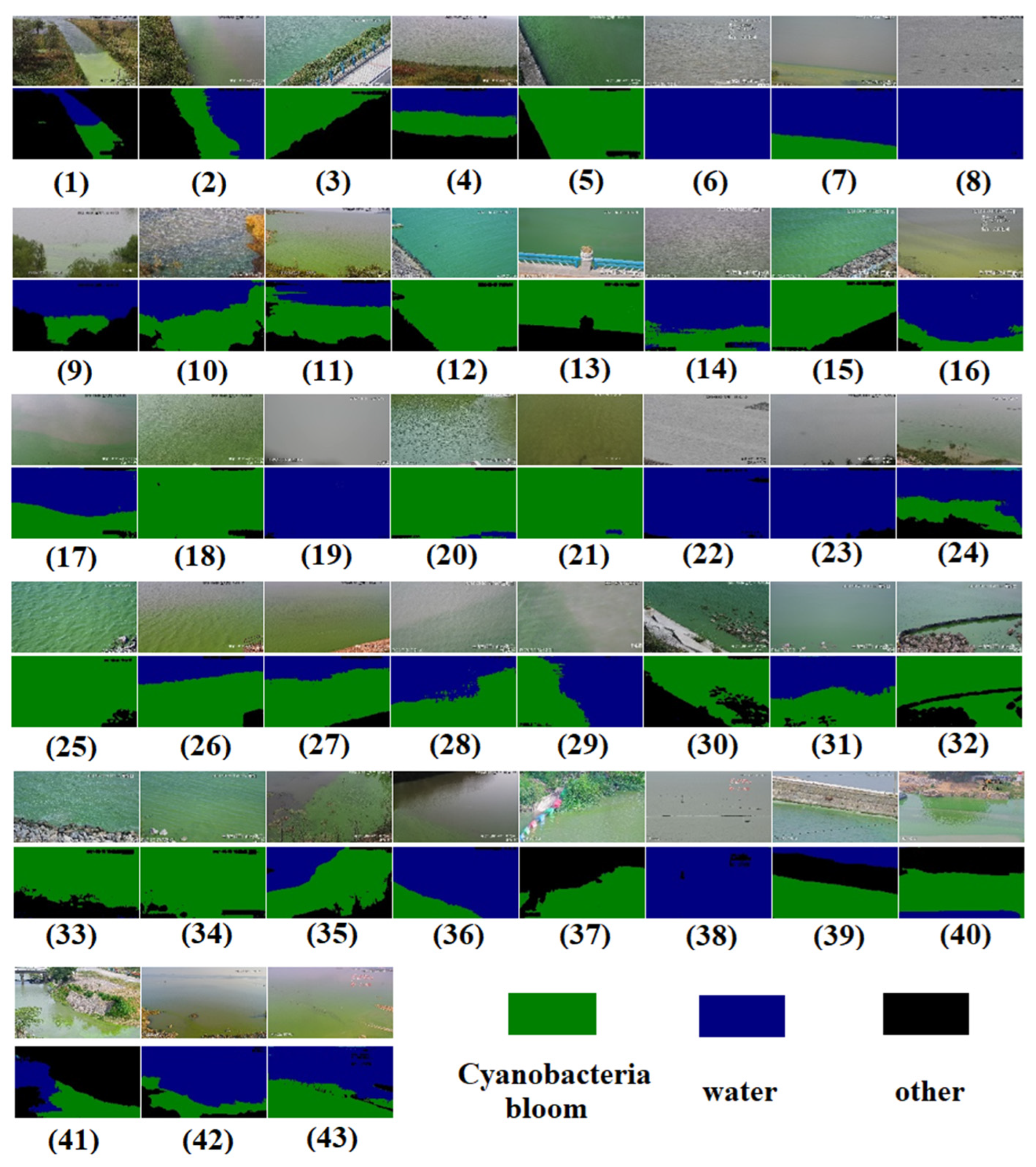
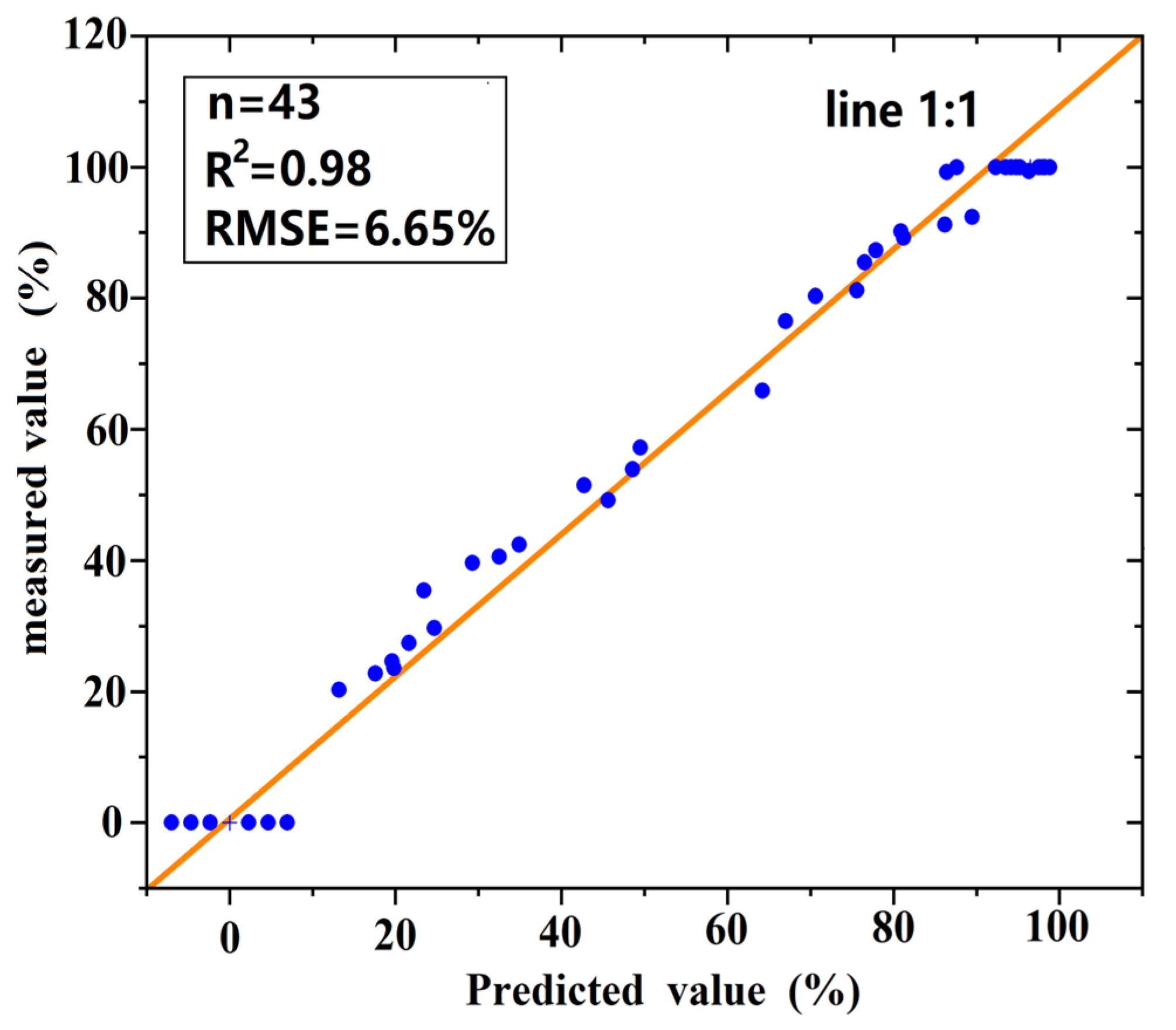
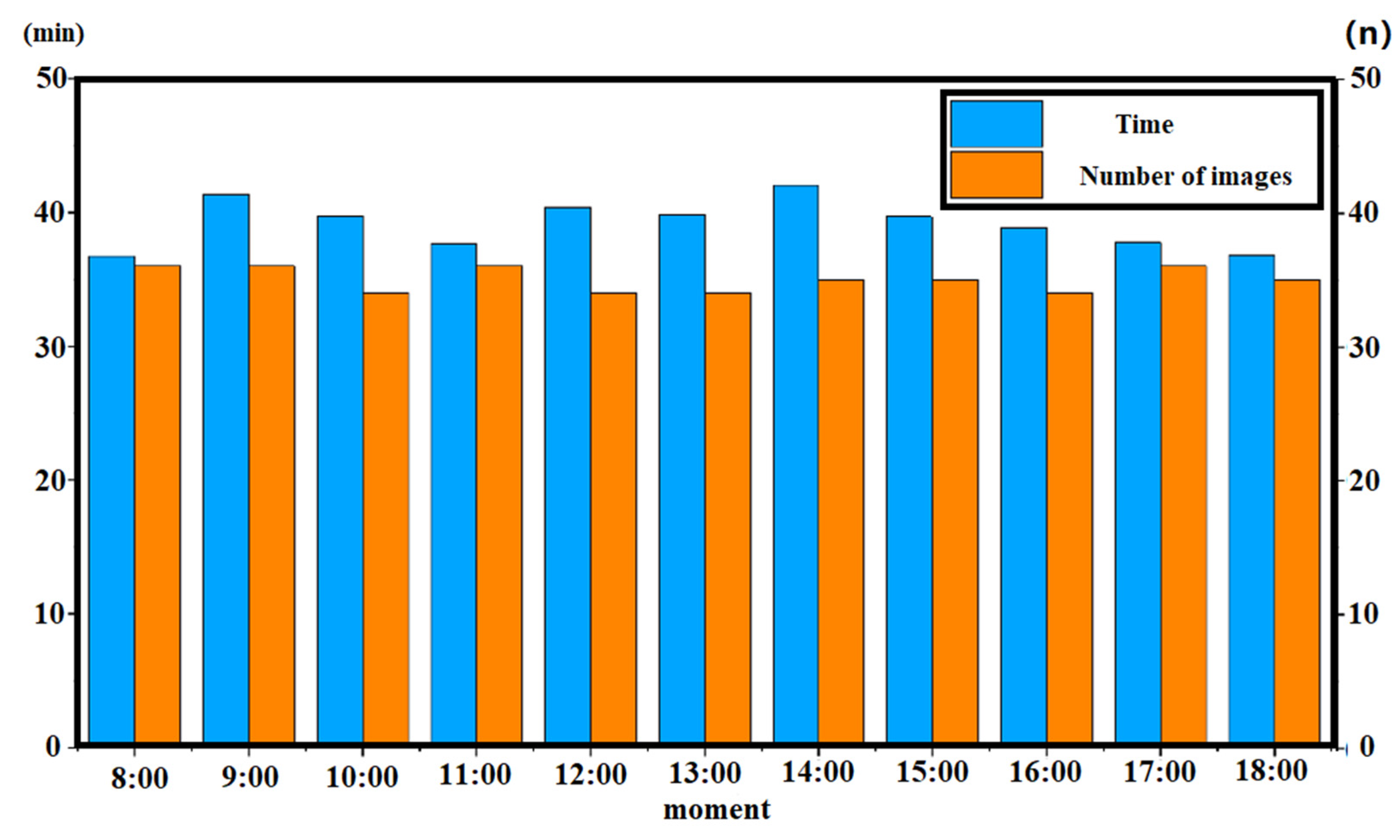
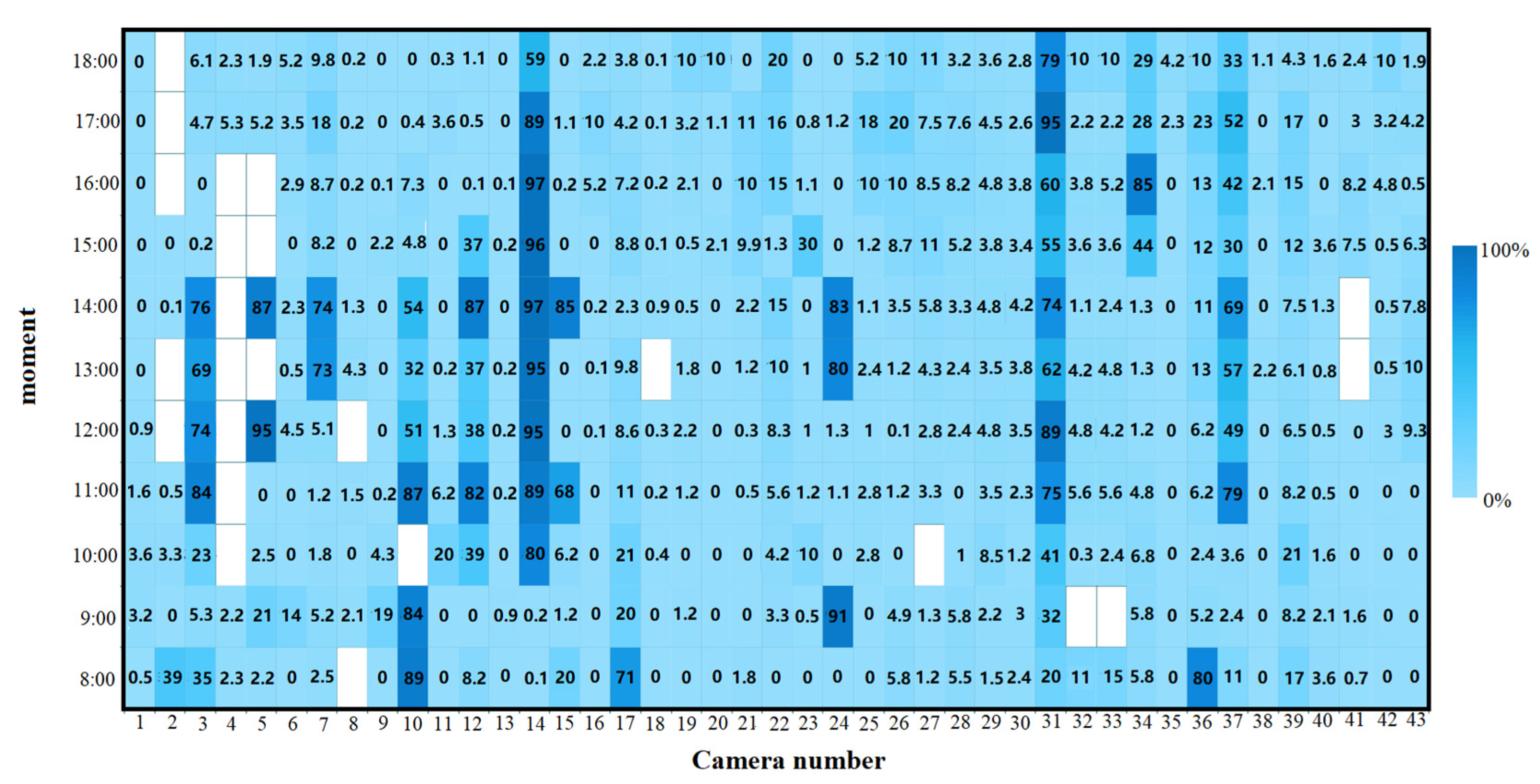
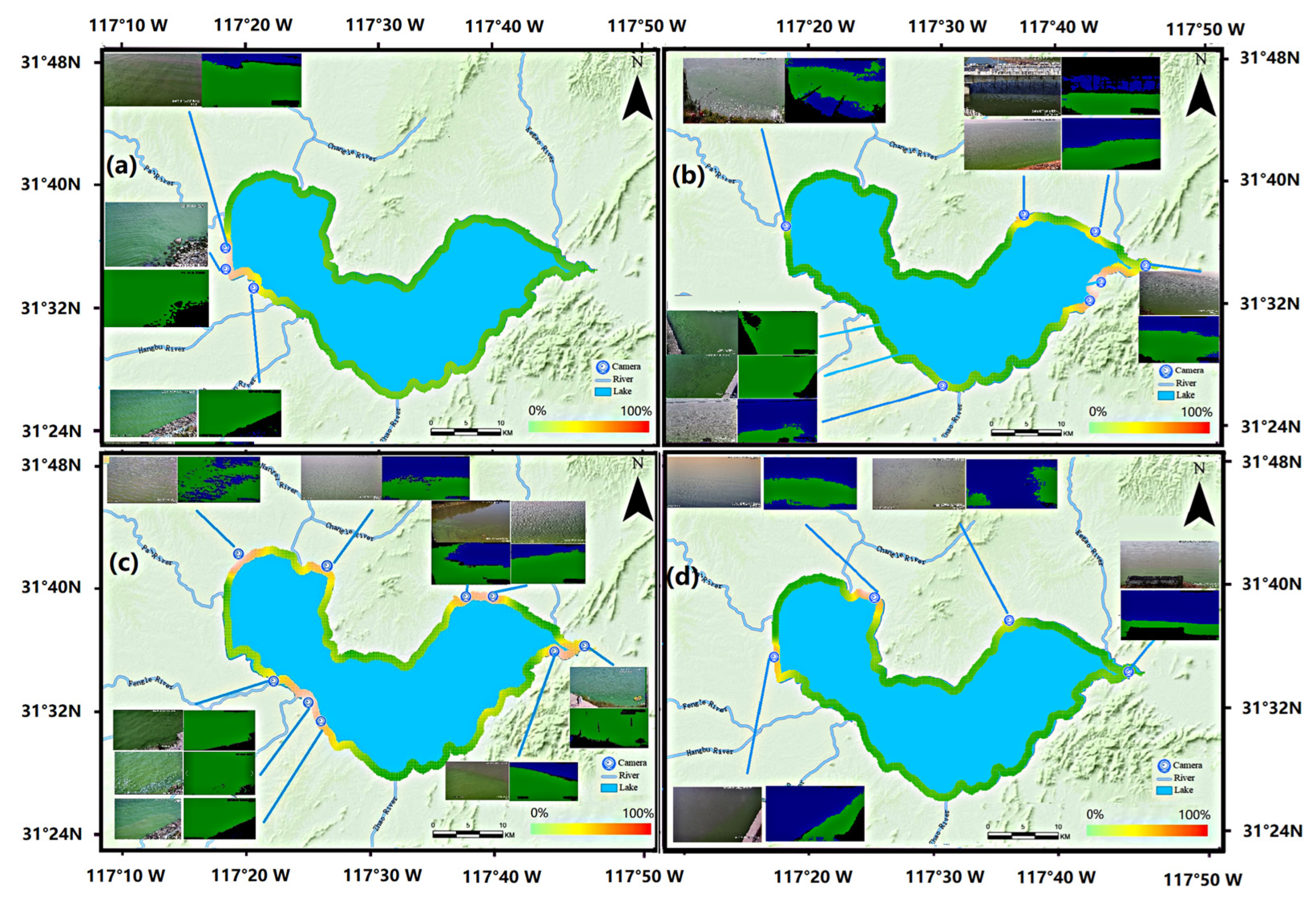
| Number of Threads | Average Time (min) | CPU Load (%) |
|---|---|---|
| 0 | 67 | 41.8 |
| 1 | 59 | 42.9 |
| 2 | 58 | 53.6 |
| 3 | 56 | 75.2 |
| 4 | 51 | 78.6 |
| 5 | 46 | 89.1 |
| 6 | 45 | 92.5 |
| 7 | 43 | 98.7 |
| Method | OA (%) | MPA (%) | mIOU (%) | Cyanobacteria Blooms-IOU (%) | Water-IOU (%) |
|---|---|---|---|---|---|
| FCN | 76.96 | 77.54 | 67.73 | 66.38 | 68.43 |
| U-net | 78.24 | 78.63 | 68.43 | 68.29 | 70.25 |
| DeeplabV3+ | 80.29 | 79.84 | 69.82 | 69.46 | 71.24 |
| FCN(ResNet-50) | 79.42 | 78.41 | 67.36 | 68.73 | 70.26 |
| U-net(ResNet-50) | 81.21 | 80.68 | 71.23 | 70.03 | 72.43 |
| DeeplabV3+(ResNet-50) | 83.27 | 81.78 | 72.42 | 71.65 | 74.38 |
Disclaimer/Publisher’s Note: The statements, opinions and data contained in all publications are solely those of the individual author(s) and contributor(s) and not of MDPI and/or the editor(s). MDPI and/or the editor(s) disclaim responsibility for any injury to people or property resulting from any ideas, methods, instructions or products referred to in the content. |
© 2023 by the authors. Licensee MDPI, Basel, Switzerland. This article is an open access article distributed under the terms and conditions of the Creative Commons Attribution (CC BY) license (https://creativecommons.org/licenses/by/4.0/).
Share and Cite
Wang, Z.; Wang, C.; Liu, Y.; Wang, J.; Qiu, Y. Real-Time Identification of Cyanobacteria Blooms in Lakeshore Zone Using Camera and Semantic Segmentation: A Case Study of Lake Chaohu (Eastern China). Sustainability 2023, 15, 1215. https://doi.org/10.3390/su15021215
Wang Z, Wang C, Liu Y, Wang J, Qiu Y. Real-Time Identification of Cyanobacteria Blooms in Lakeshore Zone Using Camera and Semantic Segmentation: A Case Study of Lake Chaohu (Eastern China). Sustainability. 2023; 15(2):1215. https://doi.org/10.3390/su15021215
Chicago/Turabian StyleWang, Zhiyong, Chongchang Wang, Yuchen Liu, Jindi Wang, and Yinguo Qiu. 2023. "Real-Time Identification of Cyanobacteria Blooms in Lakeshore Zone Using Camera and Semantic Segmentation: A Case Study of Lake Chaohu (Eastern China)" Sustainability 15, no. 2: 1215. https://doi.org/10.3390/su15021215
APA StyleWang, Z., Wang, C., Liu, Y., Wang, J., & Qiu, Y. (2023). Real-Time Identification of Cyanobacteria Blooms in Lakeshore Zone Using Camera and Semantic Segmentation: A Case Study of Lake Chaohu (Eastern China). Sustainability, 15(2), 1215. https://doi.org/10.3390/su15021215








